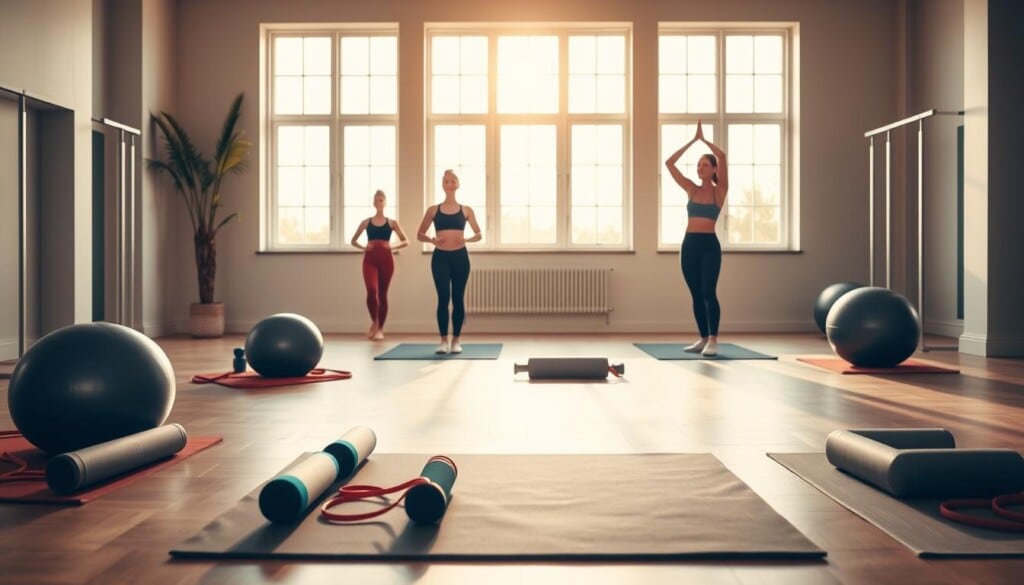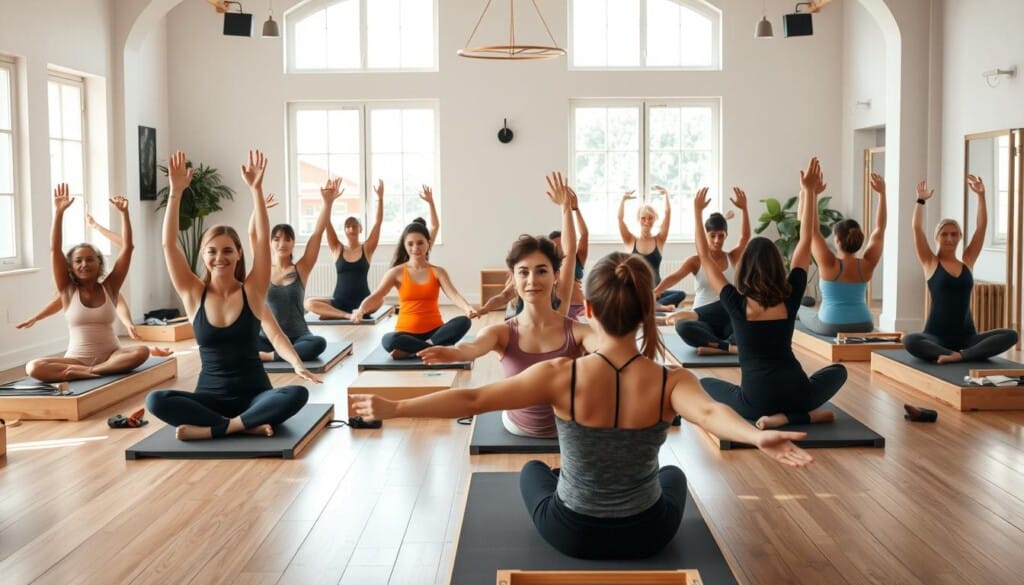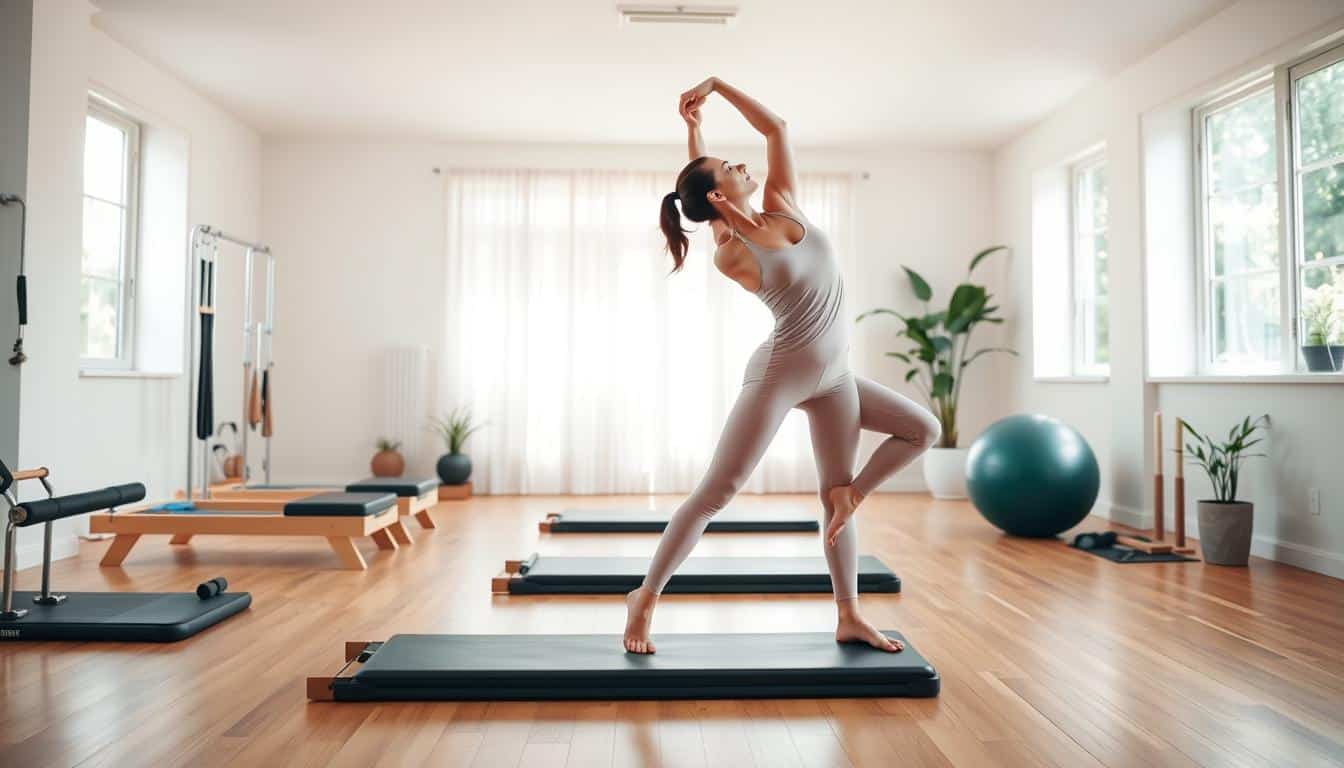Ever thought about how Pilates can change your fitness and wellness game? This guide explores Pilates’ power to boost flexibility, core strength, and well-being. Joseph Pilates created it in the early 1900s. It’s a full-body, mind-body workout that brings many benefits.
As you read on, you’ll learn key insights, techniques, and Pilates workouts. These will help take your practice and lifestyle to the next level.
Key Takeaways
- Pilates is a holistic fitness approach that enhances flexibility and core strength.
- The methodologies of Pilates focus on harmonizing body and mind.
- Regular Pilates workouts can lead to significant improvements in overall well-being.
- This guide serves as a complete resource for understanding Pilates practices.
- Exploring Pilates benefits can motivate people to practice regularly.
- By following this guide, practitioners will find effective ways to integrate Pilates into their fitness routines.
What is Pilates and Its Benefits?
Pilates is a workout that focuses on controlled movements. It was created by Joseph Pilates. It helps build core strength, improve flexibility, and enhance posture.
This exercise connects your body and mind deeply. It’s great for many people. Pilates is perfect for beginners and experienced athletes alike.
An Overview of Pilates
Pilates is all about precise movements. These movements strengthen muscles and boost flexibility. It also improves body alignment and coordination.
Originally used for rehabilitation, Pilates has grown into a full workout. It’s loved for its flexibility and effectiveness.
Key Health Benefits of Pilates
Pilates offers more than just physical benefits. It can improve your posture and muscle tone. It also helps with breathing and reduces stress.
Regular Pilates practice can make you feel better mentally. It’s a holistic way to improve your health and well-being.
Who Can Practice Pilates?
Anyone can do Pilates. It’s great for beginners. People recovering from injuries, athletes, and fitness enthusiasts can all benefit.
Pilates is inclusive. It meets the needs and goals of many people. It’s a versatile exercise for everyone.
Different Types of Pilates
Pilates offers many types to fit various fitness needs and likes. Knowing the differences helps pick the right one. We’ll look at traditional, contemporary Pilates, and the contrast between equipment and mat Pilates.
Traditional Pilates
Traditional Pilates follows Joseph Pilates’ original ideas and moves. It focuses on building core strength, stability, and flexibility. It uses Pilates equipment, like the Reformer, to add resistance and target muscles well.
Sticking to the traditional methods improves body alignment and awareness.
Contemporary Pilates
Contemporary Pilates mixes new techniques with the old. It adjusts the classic exercises for different fitness levels and goals. It keeps up with the latest in body science, making it safer and more effective.
It uses both mat Pilates and equipment, making training varied and interesting.
Pilates with Equipment vs. Mat Pilates
Pilates can be done with or without equipment, each with its own benefits. Mat Pilates uses your body weight and the mat to strengthen the core and improve flexibility. On the other hand, Pilates with equipment, like the Reformer, offers adjustable resistance for a deeper muscle workout.
Choosing between these depends on your goals, what you have access to, and your personal preference.
Essential Pilates Principles
Pilates is based on key principles that make workouts more effective. These principles help practitioners focus and move better. They focus on concentration, control, and centering, which improve body awareness and movement.
Concentration
Concentration is key in Pilates for precise movements. It makes you aware of your body’s alignment and muscle use. This focus helps you understand your movements better and track your progress.
Control
Control in Pilates means doing exercises with precision. It’s about moving slowly and correctly to avoid injuries. This helps build muscle control, making your body stronger and more stable during workouts.
Centering
Centering in Pilates means focusing on the core. The core is the power center for all movements. It improves balance, coordination, and exercise effectiveness. This principle helps stabilize the core for smooth and controlled movements.
Getting Started with Pilates
Starting Pilates involves a few key steps. First, finding classes that match your fitness level and goals is important. Knowing how to choose the right class can really help you get better at Pilates.
Choosing the Right Class
When picking Pilates classes, think about your current fitness. Beginners should look for classes that teach the basics. More experienced people might prefer classes that focus on strength or flexibility.
Finding a Local Studio with LocalZ
Finding the right Pilates studio is key. LocalZ helps you find studios near you. It shows you different options, so you can pick one that fits your needs.
Preparing for Your First Class
Getting ready for your first Pilates class is important. Wear comfy, fitted clothes that let you move easily. Knowing what the class will be like can also help you relax. Learning some basic Pilates terms can make your experience better.

Pilates Workouts for All Levels
Pilates workouts are great for everyone, no matter your fitness level. You can start with beginner Pilates, move to intermediate routines, or try advanced exercises. Each level helps improve your core strength and flexibility.
Beginner-Friendly Exercises
Beginners can begin with simple moves like the Pelvic Tilt, the Hundred, and Basic Plank. It’s important to focus on proper form and breathing. This helps engage your core muscles and build stability.
Intermediate Pilates Routines
When you get better, you can try intermediate Pilates. This includes exercises like the Swan and the Side Leg Series. These routines improve body control and strength while keeping you aligned.
Advanced Pilates Challenges
For a bigger challenge, try advanced Pilates exercises like the Teaser and the Scissors. These workouts require better coordination, strength, and endurance. They’re perfect for those who want to take their Pilates to the next level.
Incorporating Pilates into Your Fitness Routine
Adding Pilates to your routine can boost your health and happiness. Knowing how often and for how long to practice is key. People often ask how often to do Pilates to get the best results while keeping up with other workouts.
Frequency and Duration Recommendations
The CDC says adults should do at least 150 minutes of moderate exercise weekly. For Pilates fans, this means 2-3 sessions a week. Beginners should focus on doing each session right, not just how long it lasts.
Good form and technique are important. They help work your core muscles and prevent injuries.
Combining Pilates with Other Workouts
Mixing Pilates with other exercises can make your fitness routine better. Adding strength training or cardio to Pilates helps you stay balanced and flexible. It also improves your endurance.
For a complete fitness plan, check out LocalZ. They help you mix workouts to meet your personal goals.

The Role of LocalZ in Your Pilates Journey
LocalZ is a key resource for those wanting to improve their Pilates. It helps find local instructors who offer customized sessions. This makes it easier to pick an instructor who meets your needs.
Finding Pilates Instructors Near You
LocalZ is essential for finding top-notch professionals nearby. Users can search and connect with Pilates experts. This leads to training that matches your fitness goals.
Accessing Reviews and Recommendations
LocalZ also offers Pilates reviews from past clients. These reviews give insights into instructors and classes. They help you make the right choice for your next session.
Supporting Local Businesses While You Practice
Using LocalZ boosts your fitness and helps local businesses. By joining local classes, you support your community’s health scene. This benefits everyone and keeps your body in top shape.
Community and Connection in Pilates
The Pilates community grows strong through shared experiences in group classes. Practicing together boosts motivation and accountability. This supportive space makes fitness journeys more fun and keeps people coming back.
Benefits of Practicing in Groups
Being part of group classes makes you feel like you belong. Seeing others succeed inspires you, creating a positive vibe. It encourages everyone to try harder, improve, and reach their health goals together.
Local Events and Workshops
Local Pilates events and workshops offer special learning chances and connections. They let people get expert training and meet others who love fitness. These gatherings not only teach new things but also build strong bonds within the community.

Conclusion: Unleash the Power of Pilates
Starting a Pilates journey is more than just getting fit. It’s about caring for your whole self. If you’re serious about fitness, setting personal goals is key. Having a supportive community can make your progress even better.
Taking the First Step
Knowing how Pilates affects your body and mind is important. Regular practice can boost your flexibility, strength, and focus. It helps build both physical and mental strength.
Lasting Impact on Your Fitness Journey
The Pilates journey is all about getting better and trying new things. By sticking to it, you’ll see real changes in your life. These changes will improve your health and lifestyle far beyond the studio.

